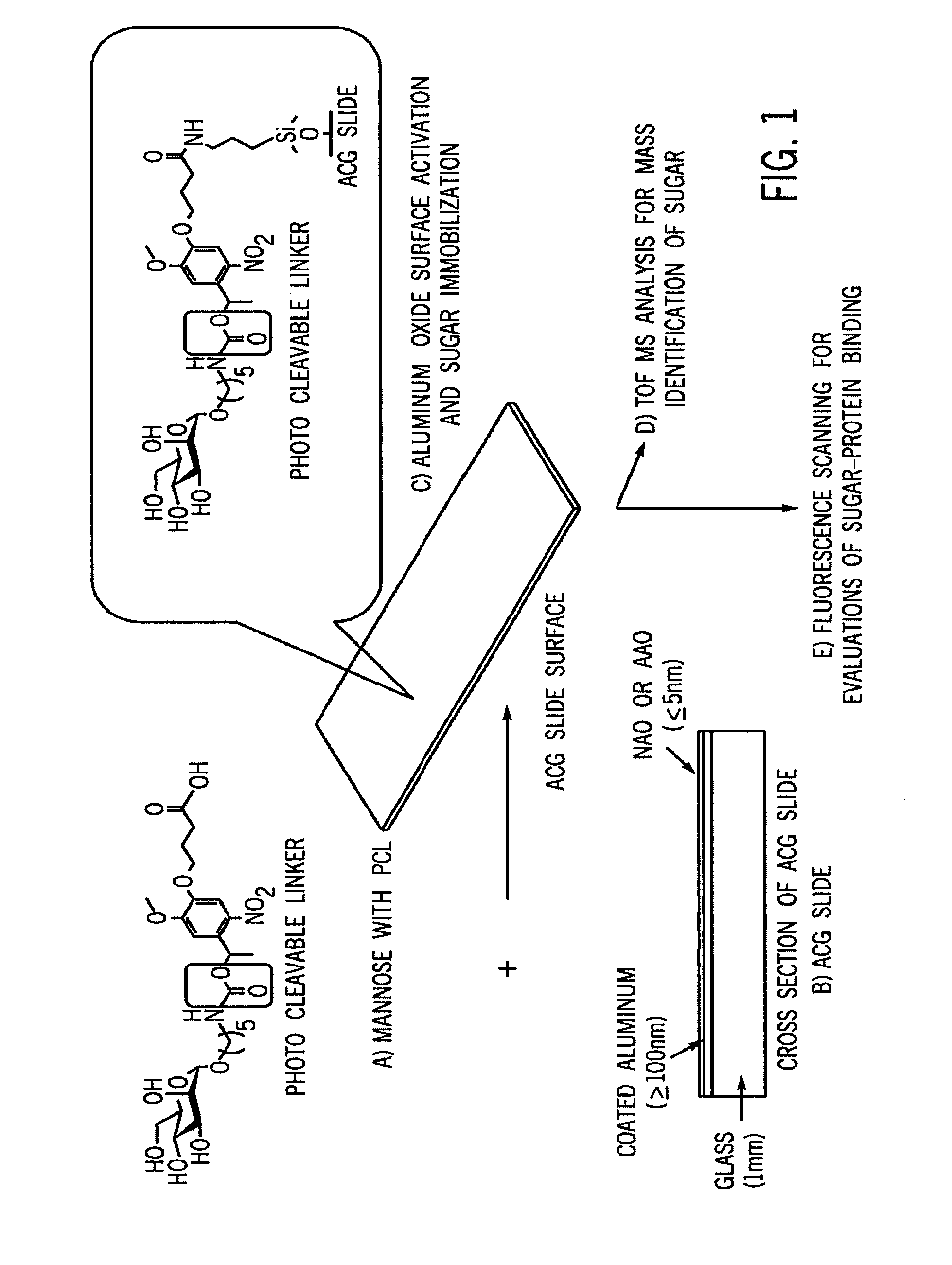Glycan arrays on ptfe-like aluminum coated glass slides and related methods
a technology of glycan arrays and glass slides, applied in the field of array technology, can solve the problems of difficult to obtain pure oligosaccharides, difficult to study carbohydrate-protein interactions, and inability to conduct direct mass spectrometry analysis, and achieve low laser fluence rate, low signal fragmentation, and high signal/noise ratio
- Summary
- Abstract
- Description
- Claims
- Application Information
AI Technical Summary
Benefits of technology
Problems solved by technology
Method used
Image
Examples
example 1
Surface Properties of ACG Slides
[0107]A layer of pure aluminum (99.999%) at least 100 nm thick was coated onto the micro glass slides by using various coating techniques, such as magnetron sputtering, cathode arc evaporation, and thermal coating. These slides were either used without further manipulation or electrically anodized before usage. According to implementations, FIG. 3 shows their surface morphology, composition, and roughness as determined by scanning electron microscopy (SEM), atomic force microscopy (AFM), and X-ray photoelectron spectroscopy (XPS) of an ACG slide. FIG. 3A shows aluminum deposited by cathode arc evaporation, FIG. 3B shows an aluminum coating deposited by magnetron sputtering, and FIG. 3C shows aluminum AAO / ACG slide obtained by thermal coating followed by electrochemical surface anodization.
[0108]As can be seen, the ACG slide produced by cathode arc evaporation has a coating of large granules and a high surface roughness. Slides with high surface roughn...
example 2
Surface Activation
[0112]In the screening experiments, plasma of oxygen, argon, and mixed gases of oxygen and argon were tested for slide-surface activation. The residues (CO, CO2, and H2O) were removed under vacuum. It is the removal of this surface contamination that contributed to the success of grafting the desired organic compounds chemically. The surface was gauged with an attenuated total reflectance Fourier transform infrared (ATR / FTIR) spectrometer. The ATR / FTIR spectra showed Al—OH peaks at around 800-1100 cm−1, as illustrated in FIG. 6, indicating that the surface had converted into Al—OH after the surface-cleaning process. According to implementations, the plasma treatment uses just enough plasma energy to clean and “tickle” the surface of the ACG slide to remove the organic contamination, but still hold the alumina layer without etching the underlying surface. The activation process was successfully completed by using a mere 6.8 W (at 680 V) of energy for 10 min under a ...
example 3
Mannose with PCL Immobilized on the Activated Surface of the ACG Slide
[0115]As shown in FIG. 2, compound 27, which has a carboxy functional group, was synthesized. A solution of HBTU and compound 27 was manually spotted and microarrayed on the activated surface of the ACG slide. Amide formation on the surface of the ACG slide took place overnight at room temperature. All salt residues, as well as unbound mannose derivative, were washed away thoroughly with methanol and deionized water. After all these preparations, the substance was ready for mass identification and protein-binding evaluation.
PUM
| Property | Measurement | Unit |
|---|---|---|
| Acidity | aaaaa | aaaaa |
| Electrical conductor | aaaaa | aaaaa |
| Transparency | aaaaa | aaaaa |
Abstract
Description
Claims
Application Information
 Login to View More
Login to View More - R&D Engineer
- R&D Manager
- IP Professional
- Industry Leading Data Capabilities
- Powerful AI technology
- Patent DNA Extraction
Browse by: Latest US Patents, China's latest patents, Technical Efficacy Thesaurus, Application Domain, Technology Topic, Popular Technical Reports.
© 2024 PatSnap. All rights reserved.Legal|Privacy policy|Modern Slavery Act Transparency Statement|Sitemap|About US| Contact US: help@patsnap.com










